
Apatite is a group of phosphate minerals, usually hydroxyapatite, fluorapatite and chlorapatite, with high concentrations of OH−, F− and Cl− ion, respectively, in the crystal. The formula of the admixture of the three most common endmembers is written as Ca10(PO4)6(OH,F,Cl)2, and the crystal unit cell formulae of the individual minerals are written as Ca10(PO4)6(OH)2, Ca10(PO4)6F2 and Ca10(PO4)6Cl2.

Halotrichite, also known as feather alum, is a highly hydrated sulfate of aluminium and iron. Its chemical formula is FeAl2(SO4)4·22H2O. It forms fibrous monoclinic crystals. The crystals are water-soluble.
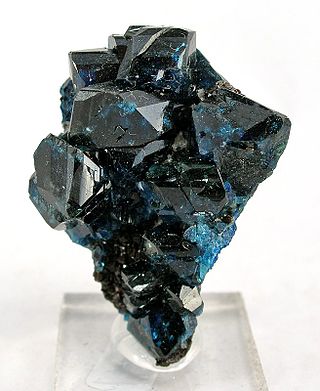
Lazulite or Azure spar is a transparent to semi-opaque, blue mineral that is a phosphate of magnesium, iron, and aluminium, with the chemical formula (Mg,Fe2+)Al2(PO4)2(OH)2. Lazulite forms one endmember of a solid solution series with the darker, iron-rich scorzalite.

Lithiophilite is a mineral containing the element lithium. It is lithium manganese(II) phosphate with chemical formula LiMnPO4. It occurs in pegmatites often associated with triphylite, the iron end member in a solid solution series. The mineral with intermediate composition is known as sicklerite and has the chemical formula Li(Mn,Fe)PO4). The name lithiophilite is derived from the Greek philos (φιλός) "friend", as lithiophilite is usually found with lithium.
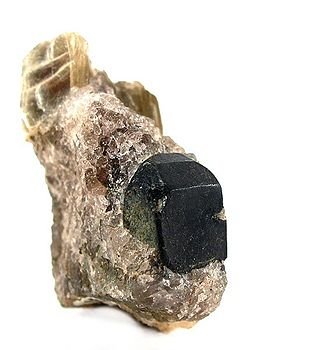
Triphylite is a lithium iron(II) phosphate mineral with the chemical formula LiFePO4. It is a member of the triphylite group and forms a complete solid solution series with the lithium manganese(II) phosphate, lithiophilite. Triphylite crystallizes in the orthorhombic crystal system. It rarely forms prismatic crystals and is more frequently found in hypidiomorphic rock. It is bluish- to greenish-gray in color, but upon alteration becomes brown to black.

Vauxite is a phosphate mineral with the chemical formula Fe2+Al2(PO4)2(OH)2·6(H2O). It belongs to the laueite – paravauxite group, paravauxite subgroup, although Mindat puts it as a member of the vantasselite Al4(PO4)3(OH)3·9H2O group. There is no similarity in structure between vauxite and paravauxite Fe2+Al2(PO4)2(OH)2·8H2O or metavauxite Fe3+Al2(PO4)2(OH)2·8H2O, even though they are closely similar chemically and all minerals occur together as secondary minerals. Vauxite was named in 1922 for George Vaux Junior (1863–1927), an American attorney and mineral collector.

Natrophilite is a mineral with the chemical formula NaMnPO4. In a pure form it has a yellow coloration. Its crystals are orthorhombic to dipyramidal. It is transparent to translucent. It is not radioactive. Natrophilite is rated 4.5 to 5 on the Mohs Scale.

Scorzalite ((Fe2+,Mg)Al2(OH,PO4)2) is a dark blue phosphate mineral containing iron, magnesium, and aluminium phosphate. Scorzalite forms one endmember of a solid solution series with the lighter, more magnesium-rich lazulite.
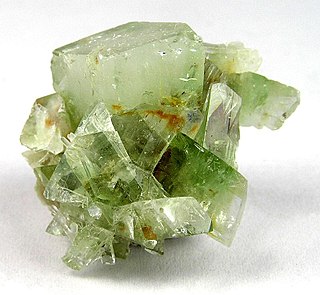
Augelite is an aluminium phosphate mineral with formula: Al2(PO4)(OH)3. The shade varies from colorless to white, yellow or rose. Its crystal system is monoclinic.

Osarizawaite is a greenish yellow sulfate mineral with the chemical formula: PbCuAl2(SO4)2(OH)6. It has rhombohedral crystals.

Berlinite (aluminium phosphate, chemical formula AlPO4 or Al(PO4)) is a rare high-temperature hydrothermal or metasomatic phosphate mineral. It has the same crystal structure as quartz with a low temperature polytype isostructural with α–quartz and a high temperature polytype isostructural with β–quartz. Berlinite can vary from colorless to greyish or pale pink and has translucent crystals.
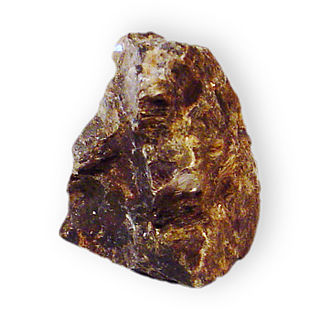
Alluaudite is a relatively common alkaline manganese iron phosphate mineral with the chemical formula (Na,Ca)Mn2+(Fe3+,Mn2+,Fe2+,Mg)2(PO4)3. It occurs as metasomatic replacement in granitic pegmatites and within phosphatic nodules in shales.
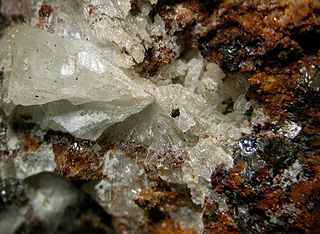
Fluellite is a mineral with the chemical formula Al2(PO4)F2(OH)•7H2O. The name is from its chemical composition, being a fluate of alumine (French).

Woodhouseite belongs to the beudantite group AB3(XO4)(SO4)(OH)6 where A = Ba, Ca, Pb or Sr, B = Al or Fe and X = S, As or P. Minerals in this group are isostructural with each other and also with minerals in the crandallite and alunite groups. They crystallise in the rhombohedral system with space group R3m and crystals are usually either tabular {0001} or pseudo-cubic to pseudo-cuboctahedral. Woodhouseite was named after Professor Charles Douglas Woodhouse (1888–1975), an American mineralogist and mineral collector from the University of California, Santa Barbara, US, and one-time General Manager of Champion Sillimanite, Inc.

Ludlamite is a rare phosphate mineral with chemical formula (Fe,Mn,Mg)3(PO4)2·4H2O. It was first described in 1877 for an occurrence in Wheal Jane mine in Cornwall, England and named for English mineralogist Henry Ludlam (1824–1880).

Wairakite is a zeolite mineral with an analcime structure but containing a calcium ion. The chemical composition is Ca8(Al16Si32O96)•16H2O. It is named for the location of its discovery in Wairakei, North Island, New Zealand, by Czechoslovakian mineralogist Alfred Steiner in 1955. The first finds were in hydrothermally altered rhyolitic tuffs, ignimbrites and volcaniclastic rocks. The mineral has since been found in metamorphic rocks and in geothermal areas. It was most likely first successfully synthesized in a laboratory in 1970.
Penikisite was discovered by Alan Kulan and Gunar Penikis near Rapid Creek, Yukon Territory. The mineral is a member of the bjarebyite group along with kulanite, ideally BaFe2+2Al2(PO4)3(OH)3, and bjarebyite, ideally BaMn2+2Al2(PO4)3(OH)3. It is among several new minerals that have been discovered in the Rapid Creek and Big Fish areas of Yukon Territory. Kulanite is similar in many ways to penikisite in appearance and properties. The chemical formula for penikisite is Ba(Mg,Fe,Ca)Al2(PO4)2(OH)3. It has a hardness of about 4 and a density of 3.79 g/cm3. Penikisite is unique among the bjarebyite group in being monoclinic and has a biaxial optical class. It comes in shades of blue and green and, when rubbed on a streak plate, is pale green to white in color. Although penikisite and kulanite both range from blue to green, penikisite zones are easily distinguishable from kulanite zones in kulanite-penikisite crystals because they are lighter than the darker kulanite in color. Penikisite is a phosphate and is different from kulanite in that it is a magnesium-rich phosphate whereas kulanite is an iron-rich phosphate.

Aluminocopiapite (IMA symbol: Acpi) is an aluminium iron sulfate mineral with the chemical formula Al2/3Fe3+4(SO4)6(OH)2·20H2O. Its type localities are Fortymile River in Alaska and the San Rafael Swell in Utah.
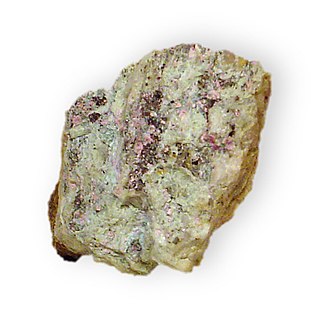
Alumohydrocalcite (IMA symbol: Ahcal) is a calcium aluminium carbonate mineral with the chemical formula CaAl2(CO3)2(OH)4·4H2O. Its type locality is Khakassia, Russia.

Senegalite is a rare aluminum phosphate. It is a hydrated hydroxy phosphate of aluminum. It is named after Senegal, the country in which it was first found to occur.



















